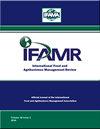室内农场的生产规划:利用时间和空间要求确定高效生产计划和农场规模
IF 1.5
4区 经济学
Q3 AGRICULTURAL ECONOMICS & POLICY
International Food and Agribusiness Management Review
Pub Date : 2024-02-23
DOI:10.22434/ifamr2023.0038
引用次数: 0
摘要
与传统农业系统相比,室内农业利用先进技术减少了 95% 的用水量,单位土地产量提高了 100 倍。即使在气候条件较差的城市,这些封闭系统也能全年生产无农药的新鲜食品,从而解决城市地区的食品荒漠问题并创造就业机会。然而,该产业面临着巨大挑战,主要原因是投资和运营成本巨大,而对这些系统内投入产出关系的了解有限又加剧了这一挑战。本研究采用生物经济学框架,根据生长周期持续时间(时间)和所需种植面积(空间)建立基础生产函数。通过部分预算分析,确定了 19 天的生产计划,以提供最高的利润贡献率。结果将该假想生菜室内农场的最小面积设定为 273 平方米,使其适合安装在城市地区。在 800 平方米的种植面积内,农场每天收获 118 公斤生菜,分布在四个垂直堆叠的架子上。此外,还介绍了美国经济产出对外生因素敏感性的估计,以及成本最小化战略和收入最大化战略之间的比较。本文章由计算机程序翻译,如有差异,请以英文原文为准。
Production planning in an indoor farm: Using time and space requirements to define an efficient production schedule and farm size
Indoor agriculture is an innovative and environmentally sustainable approach to high-quality food production, utilizing advanced technology to reduce water usage by 95% and achieve a 100-fold increase in production per unit of land compared to conventional farming systems. These enclosed systems provide year-round production of pesticide-free fresh food, even in cities with less favourable climates, addressing food deserts and creating employment opportunities in urban areas. However, the industry faces significant challenges, primarily stemming from substantial investment and operating costs, exacerbated by a limited understanding of the input-output relationship within these systems. This study employs a bioeconomic framework to establish a foundational production function based on growth cycle duration (time) and required growing area (space). Through a partial budget analysis, a 19-day production schedule was identified to provide the highest contribution margin to profits. Results set the minimum size of this hypothetical lettuce indoor farm at 273 m2, rendering it suitable for installation in urban areas. The farm harvests 118 kg per day, within an 800 m2 growing area distributed across four vertically stacked shelves. Estimates of economic output sensitivity to exogenous factors in the US context are also presented, along with a comparison between cost-minimizing and revenue-maximizing strategies.
求助全文
通过发布文献求助,成功后即可免费获取论文全文。
去求助
来源期刊

International Food and Agribusiness Management Review
AGRICULTURAL ECONOMICS & POLICY-
CiteScore
2.90
自引率
0.00%
发文量
0
审稿时长
>12 weeks
期刊介绍:
The IFAMR is an internationally recognized catalyst for discussion and inquiry on issues related to the global food and agribusiness system. The journal provides an intellectual meeting place for industry executives, managers, scholars and practitioners interested in the effective management of agribusiness firms and organizations.
IFAMR publishes high quality, peer reviewed, scholarly articles on topics related to the practice of management in the food and agribusiness industry. The Journal provides managers, researchers and teachers a forum where they can publish and acquire research results, new ideas, applications of new knowledge, and discussions of issues important to the worldwide food and agribusiness system. The Review is published electronically on this website.
The core values of the Review are as follows: excellent academic contributions; fast, thorough, and detailed peer reviews; building human capital through the development of good writing skills in scholars and students; broad international representation among authors, editors, and reviewers; a showcase for IFAMA’s unique industry-scholar relationship, and a facilitator of international debate, networking, and research in agribusiness.
The Review welcomes scholarly articles on business, public policy, law and education pertaining to the global food system. Articles may be applied or theoretical, but must relevant to managers or management scholars studies, industry interviews, and book reviews are also welcome.
 求助内容:
求助内容: 应助结果提醒方式:
应助结果提醒方式:


